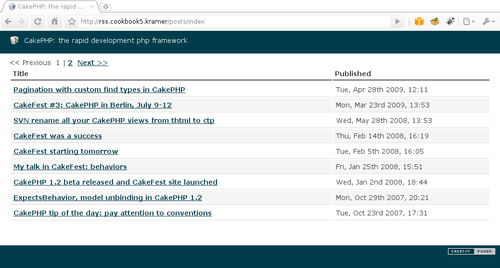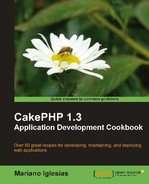This recipe shows how to get content from remote RSS feeds using a datasource.
We start by installing the fork of CakePHP's datasources plugin. Download the latest release from http://github.com/mariano/datasources/downloads and uncompress the downloaded file into your app/plugins folder. You should now have a directory named datasources. The fork used in this recipe uses a refactored version of the RSS datasource developed by Donatas Kairys, member of Loadsys Consulting. This modified version improves the datasource performance, and adds the possibility of changing the feed URL through a find setting. More information about the original datasource can be obtained at http://blog.loadsys.com/2009/06/19/cakephp-rss-feed-datasource.
- We start by creating a connection to use the RSS datasource. Open your
app/config/database.phpfile and add the following connection:public $feed = array( 'datasource' => 'datasources.RssSource', 'url' => 'http://marianoiglesias.com.ar/category/cakephp/feed/' );
- Create a model named
Postin a file namedpost.phpand place it in yourapp/modelsfolder with the following contents:<?php class Post extends AppModel { public $useDbConfig = 'feed'; } ?> - Create its controller in a file named
posts_controller.phpand place it in yourapp/controllersfolder with the following contents:<?php class PostsController extends AppController { public $helpers = array('Time'), public function index() { $this->paginate = array( 'order' => array('pubDate' => 'desc'), 'limit' => 9 ); $this->set('posts', $this->paginate()); } } ?> - Finally, we need to create the view. Create a folder named
postsin yourapp/viewsfolder, and in that folder create a file namedindex.ctpwith the following contents:<p> <?php echo $this->Paginator->prev(); ?> <?php echo $this->Paginator->numbers(); ?> <?php echo $this->Paginator->next(); ?> </p> <table> <thead><tr><th>Title</th><th>Published</th></tr></thead> <tbody> <?php foreach($posts as $post) { ?> <tr> <td><?php echo $this->Html->link($post['Post']['title'], $post['Post']['link']); ?></td> <td><?php echo $this->Time->nice($post['Post']['pubDate']); ?></td> </tr> <?php } ?> </tbody> </table>
If we now browse to http://localhost/posts, we should see a paginated list of posts, as shown in the following screenshot:

We start by creating a new connection named feed, specifying datasources.FeedSource as its type. We use the setting url to specify the address of the feed source. Among other available connection settings we have:
encoding: Sets the character encoding to use. Defaults to the CakePHPApp.encodingconfiguration setting.cache: If set tofalse, no caching will be done. Otherwise this is the cache configuration name to use. Defaults to the configuration nameddefault.
We then create the Post model, specifying its underlying connection to be feed through the useDbConfig property. We then proceed to setup a paginated list of posts sorting by publication date (pubDate field) in descending order, and limiting to nine posts per page.
Just as with the CSV datasource shown in the recipe, Parsing CSV files with a datasource, the RSS datasource allows some basic filtering. For example, to only show posts that were created in the year 2009 or later, we would add the following conditions setting to our index() method:
public function index()
{
$this->paginate = array(
'conditions' => array('pubDate >=' => '2009-01-01'),
'order' => array('pubDate' => 'desc'),
'limit' => 9
);
$this->set('posts', $this->paginate());
}
There are cases where we might not be able to define the feed URL in a configuration file, for example, if the URL comes from a dynamic data source. Fortunately, for these cases we have the option to define the feed address through a custom find setting.
In the above example, we could remove the feed URL from the connection settings, and specify it as a find setting named url:
$this->paginate = array(
'url' => 'http://marianoiglesias.com.ar/category/cakephp/feed/',
'order' => array('pubDate' => 'desc'),
'limit' => 9
);
$this->set('posts', $this->paginate());
We've seen how we can change the feed URL by using a custom find setting. However, we could also change this address by modifying the connection settings. Using the method setConfig(), available in all datasources, we can make changes to any connection setting. For example, instead of using the url custom find setting, we'll change the feed URL by changing the connection:
$this->Post->getDataSource()->setConfig(array(
'url' => 'http://marianoiglesias.com.ar/category/cakephp/feed/'
));
$this->paginate = array(
'order' => array('pubDate' => 'desc'),
'limit' => 9
);
$this->set('posts', $this->paginate());
